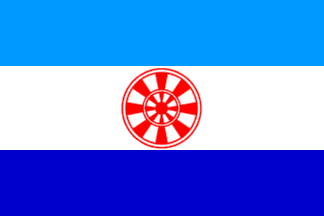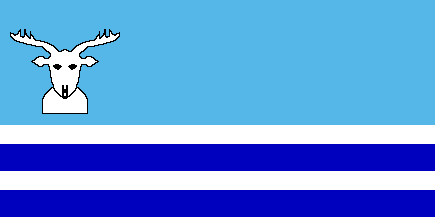
Last modified: 2006-07-29 by antonio martins
Keywords: evenk | evenkia | elk | wheel | two shades of blue | day | night | pole | kumalan | carpet | sun |
Links: FOTW homepage |
search |
disclaimer and copyright |
write us |
mirrors

(Note: You need an Unicode-aware software and font to correctely view the cyrillic text on this page. See here transliteration details).
This vast but sparsely populated territory was established in 1930.
The majority of the inhabitants are Russian settlers, the Evenki
being a minority.
Stuart Notholt
According to Mikhail Revnivtsev’s paper in Vexilologie 104:
1985-1986 (June 1997) [rev97],
the horizontal stripes are light blue - white - dark blue (27:34:27); the
kumalan (red-white ceremonial carpet) has eight “rays”; the flag ratio
is 2:3. The colors of the flag symbolize polar days and nights, the
kumalan (which itself stands for Sun) is a symbol of Evenki culture.
The flag has been approved by the Suglan, the district assembly, on March
23rd, 1995 (decree Nº 83-3). The gaps between kumalan and the blue
stripes’ margins seem to be identical to the width of the outer margin
of the kumalan, but this measure is not given.
Jan Zrzavy, 10 Mar 2002
The author of the evenkian flag is an artist, Sergei Salatkin
(Сергей
Салаткин).
Victor Lomantsov, 10 Mar 2002
According to Jiri Tenora [jtn02],
the emblem in the middle of the Evenkia flag is a sun symbol.
Ivan Sache, 18 Apr 2002

This flag, with the upper stripe in light blue, is listed under
number 120 at the chart Flags
of Aspirant Peoples [eba94] as:
«Evenkia (Evenki [Tunguses]) - Central Siberia».
Ivan Sache, 15 Sep 1999
eve.gif)
Adopted in 1998.
Chrystian Kretowicz, 27 Mar 2001
eve92.gif)
Emblem of Evenki Autonomous Okrug of Russian Federation 1992-1998.
The date 1930 refers to formation of the National Okrug within
RSFSR.
Chrystian Kretowicz, 27 Mar 2001
Anything below this line was not added by the editor of this page.